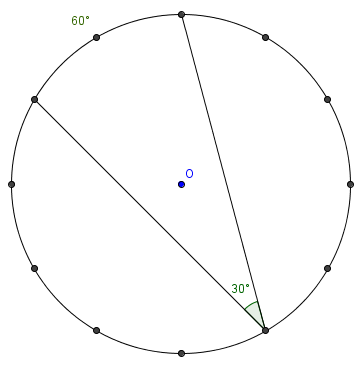Difference between revisions of "2007 AMC 12A Problems/Problem 8"
(→Solution 2) |
(→Solution 2) |
||
| Line 9: | Line 9: | ||
We look at the angle between 12, 5, and 10. It subtends <math>\frac 16</math> of the circle, or <math>60</math> degrees (or you can see that the [[arc]] is <math>\frac 23</math> of the [[right angle]]). Thus, the angle at each vertex is an [[inscribed angle]] subtending <math>60</math> degrees, making the answer <math>\frac 1260 = 30^{\circ} \Longrightarrow \mathrm{(C)}</math> | We look at the angle between 12, 5, and 10. It subtends <math>\frac 16</math> of the circle, or <math>60</math> degrees (or you can see that the [[arc]] is <math>\frac 23</math> of the [[right angle]]). Thus, the angle at each vertex is an [[inscribed angle]] subtending <math>60</math> degrees, making the answer <math>\frac 1260 = 30^{\circ} \Longrightarrow \mathrm{(C)}</math> | ||
==Solution 2== | ==Solution 2== | ||
| − | Consider one chord from 12 to 5 on the clockface. Since this chord subtends 5 of the 12 given hours, it subtends an angle at the center corresponding to <math>\frac{5}{12}</math> x <math>360</math> degrees. Given every triangle has a unique circumcircle, we can construct a quadrilateral from that triangle within that circumcircle. Hence the required angle, being in a cyclic quadrilateral, is supplementary to <math>150</math> degrees %\Longrightarrow% | + | Consider one chord from 12 to 5 on the clockface. Since this chord subtends 5 of the 12 given hours, it subtends an angle at the center corresponding to <math>\frac{5}{12}</math> x <math>360</math> degrees. Given every triangle has a unique circumcircle, we can construct a quadrilateral from that triangle within that circumcircle. Hence the required angle, being in a cyclic quadrilateral, is supplementary to <math>150</math> degrees %\Longrightarrow% <math>\mathrm{(C)}</math> |
==See also== | ==See also== | ||
Revision as of 01:54, 20 July 2016
Contents
[hide]Problem
A star-polygon is drawn on a clock face by drawing a chord from each number to the fifth number counted clockwise from that number. That is, chords are drawn from 12 to 5, from 5 to 10, from 10 to 3, and so on, ending back at 12. What is the degree measure of the angle at each vertex in the star polygon?
![]()
Solution
We look at the angle between 12, 5, and 10. It subtends ![]() of the circle, or
of the circle, or ![]() degrees (or you can see that the arc is
degrees (or you can see that the arc is ![]() of the right angle). Thus, the angle at each vertex is an inscribed angle subtending
of the right angle). Thus, the angle at each vertex is an inscribed angle subtending ![]() degrees, making the answer
degrees, making the answer ![]()
Solution 2
Consider one chord from 12 to 5 on the clockface. Since this chord subtends 5 of the 12 given hours, it subtends an angle at the center corresponding to ![]() x
x ![]() degrees. Given every triangle has a unique circumcircle, we can construct a quadrilateral from that triangle within that circumcircle. Hence the required angle, being in a cyclic quadrilateral, is supplementary to
degrees. Given every triangle has a unique circumcircle, we can construct a quadrilateral from that triangle within that circumcircle. Hence the required angle, being in a cyclic quadrilateral, is supplementary to ![]() degrees %\Longrightarrow%
degrees %\Longrightarrow% ![]()
See also
| 2007 AMC 12A (Problems • Answer Key • Resources) | |
| Preceded by Problem 7 |
Followed by Problem 9 |
| 1 • 2 • 3 • 4 • 5 • 6 • 7 • 8 • 9 • 10 • 11 • 12 • 13 • 14 • 15 • 16 • 17 • 18 • 19 • 20 • 21 • 22 • 23 • 24 • 25 | |
| All AMC 12 Problems and Solutions | |
The problems on this page are copyrighted by the Mathematical Association of America's American Mathematics Competitions. ![]()










